Phonics Worksheet for Kindergarten
If you are looking for kindergarten phonics worksheets then your search ends here.

simple process for practicing phonics with kindergarten worksheets:
Choose the phonics Worksheet for kindergarten:
Select a phonics worksheet appropriate for your child’s skill level. You can find these online or create your own.
Prepare Materials for kindergarten phonics worksheets:
Gather materials such as pencils, crayons, and markers for your child to use.
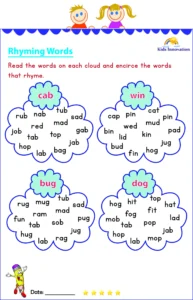
Explain the Task for phonics:
Sit down with your child and explain the task on the worksheet. For example, you might be focusing on a specific letter sound or word family.
Demonstrate:
Show your child how to complete a sample problem or section of the worksheet.
Guided Practice for phonics:
Work together on the first few problems to ensure your child understands the concept.
Independent Practice:
Allow your child to work on the worksheet independently, encouraging them to sound out letters and words.

free kindergarten tracing & painting worksheets
Provide Feedback: Offer praise for correct answers and gentle guidance for any mistakes.
Review and Discuss: After completing the worksheet, review it together. Discuss any errors and correct them.
Homework: Depending on the pace and age of your child, you might assign additional worksheets for homework.
Repeat: Practice phonics regularly with different worksheets to reinforce learning.
Remember to keep the practice sessions fun and engaging to maintain your child’s interest in learning phonics.
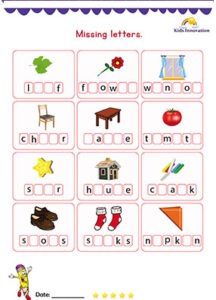
Preschool phonics learning is a crucial early education component that focuses on teaching young children about the relationship between letters and the sounds they represent. This foundational skill is essential for reading and writing development. Here are some key aspects of preschool phonics learning:
Letter Recognition: Preschoolers start by learning to recognize and identify letters of the alphabet. This can be done through fun activities, games, and colorful visuals.
Letter-Sound Correspondence: Children are introduced to the sounds that each letter makes. For instance, they learn that “A” makes the /a/ sound as in “apple.”
Phonemic Awareness: Preschoolers develop an understanding of the smallest units of sound (phonemes) in words. They practice listening for and identifying the beginning and ending sounds in words.
Blending: Children learn to combine individual sounds to form words. For example, they might practice blending /c/ /a/ /t/ to say the word “cat.”
Segmenting: This skill involves breaking words into their individual sounds, which is crucial for spelling. Preschoolers might learn to segment “dog” into /d/ /o/ /g/.
Rhyming and Word Families: Rhyming games and word families help children see patterns in language, making it easier to learn new words.
Sight Words: Some high-frequency words are introduced as sight words, as they don’t follow regular phonetic rules. Children memorize these words to improve reading fluency.
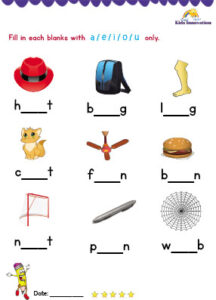
Hands-On Activities: Preschool phonics learning is often interactive and includes activities like using magnetic letters, word-building with letter tiles, and phonics-based books.
Multisensory Approaches: Many preschools use multisensory techniques, incorporating touch, sight, and sound to reinforce phonics concepts.
Gradual Progression: Phonics instruction typically follows a structured, sequential approach, starting with simple letter-sound combinations and gradually progressing to more complex phonics patterns.
Reading Readiness: Phonics lays the foundation for reading, and as preschoolers become more proficient, they are better prepared to decode and read simple texts.
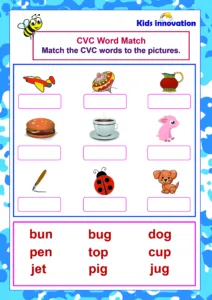
Effective preschool phonics learning provides children with the tools they need to become confident readers and writers as they progress through their educational journey. It’s an essential component of early literacy development.
Consonant blending worksheet for Kindergarten
Consonant blending worksheets are valuable tools for kindergarten students to develop essential phonemic awareness and reading skills. These worksheets provide interactive and engaging activities that help young learners practice combining consonant sounds to form words. In this comprehensive discussion, I will explore the importance of consonant blending worksheets in kindergarten practice and provide an in-depth analysis of their structure and content.

I. Introduction
Kindergarten is a crucial stage in a child’s educational journey, as it lays the foundation for reading and language development. Consonant blending is an essential skill that enables children to combine individual consonant sounds to form words. By mastering this skill, students become more proficient readers and gain confidence in their language abilities. Consonant blending worksheets are designed to make this learning process both fun and educational.
II. Importance of Consonant Blending Worksheets
Consonant blending worksheets serve several important purposes in kindergarten education:
Phonemic Awareness: Phonemic awareness is the ability to recognize and manipulate individual sounds in spoken words. Consonant blending worksheets help children identify and blend consonant sounds, enhancing their phonemic awareness.
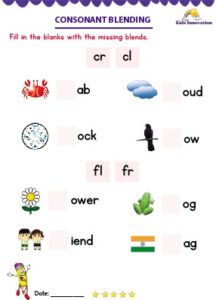
Reading Readiness: A strong foundation in consonant blending is crucial for reading readiness. As students blend consonant sounds, they become more proficient at decoding words and recognizing patterns in the English language.
Vocabulary Development: Consonant blending worksheets introduce young learners to a variety of words, allowing them to expand their vocabulary as they practice forming new words by blending sounds.
Confidence Building: As children complete worksheets and successfully blend consonant sounds, they gain confidence in their ability to read and pronounce words correctly. This confidence is vital for their overall learning journey.
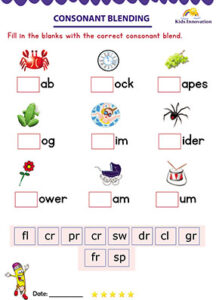
III. Structure of Consonant Blending Worksheets
Consonant blending worksheets are thoughtfully structured to cater to the developmental needs of kindergarten students. Here are some key elements that can be found in these worksheets:
Consonant Pairing: Worksheets often focus on specific pairs of consonants to ensure that students practice blending sounds effectively. Common pairings include “bl,” “br,” “cl,” “cr,” “dr,” “fr,” “gl,” “gr,” “pl,” “pr,” “sc,” “sk,” “sl,” “sm,” “sn,” “sp,” “st,” “sw,” and “tr.”
Visual Aids: Many worksheets incorporate pictures or illustrations next to the consonant pair to help children associate the sounds with the corresponding words. For example, there might be a picture of a “clam” next to “cl” or a “snake” next to “sn.”
Guided Practice: Worksheets provide examples and guided practice exercises to teach children how to blend consonant sounds. These examples help them understand the process before attempting more independent exercises.
Word Building: Students are often given letter tiles or boxes where they can arrange the consonants to create words. This hands-on approach makes learning more interactive and engaging.
Word Lists: Worksheets often include word lists with a mix of real words and nonsense words. This variety helps students learn to differentiate between actual words and random combinations of sounds.
Progressive Difficulty: Worksheets typically progress in difficulty, starting with basic consonant blends and gradually introducing more complex blends and longer words.
Color Coding: Some worksheets use color-coding techniques to help students visually distinguish between the individual consonant sounds within a word, making it easier for them to identify and blend the sounds.
IV. Content of Consonant Blending Worksheets
The content of consonant blending worksheets is diverse and caters to various learning styles. Here are some common exercises and activities found in these worksheets:
Matching: Students may be asked to match pictures with words that contain consonant blends. For instance, they might need to match a picture of a “flag” with the corresponding word.
Fill in the Blanks: These exercises involve filling in the missing consonant blends in words. For example, students may be given “cl__ck” and need to write “clock.”
Word Puzzles: Word puzzles, such as crosswords or word searches, can help reinforce consonant blending skills while adding an element of fun to the learning process.
Sentence Building: More advanced worksheets may include sentence-building activities where students use consonant blends to complete sentences.
Read and Color: This activity combines coloring with reading practice. Students read words containing consonant blends and color in a corresponding picture.
Sorting: Children may be asked to sort words into categories based on the consonant blends they contain. This activity helps reinforce their understanding of sound patterns.
Flashcards: Some worksheets provide printable flashcards with consonant blends that students can cut out and use for review and practice.
V. Benefits of Consonant Blending Worksheets
Consonant blending worksheets offer several benefits to kindergarten students and educators:
Engagement: These worksheets make learning fun and engaging, keeping children motivated to practice their consonant blending skills.
Independence: Worksheets can be completed independently, allowing students to work at their own pace and develop self-reliance.
Reinforcement: The repetitive nature of the exercises helps reinforce consonant blending skills, making them more ingrained in a child’s learning.
Assessment: Educators can use completed worksheets to assess a student’s progress and identify areas where they may need additional support.
Customization: Teachers can select worksheets that align with their students’ needs and adapt them to suit different learning levels.
Skill Development: Consonant blending worksheets support the development of crucial language skills that are foundational for reading and writing.
VI. Integration into Kindergarten Curriculum
Consonant blending worksheets can be seamlessly integrated into the kindergarten curriculum. They align with the following educational goals:
Reading Skills: These worksheets directly contribute to the development of reading skills by helping students decode words and understand phonetic patterns.
Phonemic Awareness: Kindergarten curriculum often includes phonemic awareness as a key learning objective. Consonant blending worksheets are a practical tool for teaching this concept.
Vocabulary Expansion: As students practice blending consonant sounds to form words, they naturally expand their vocabulary, a critical aspect of language development.
Language Arts: These worksheets are an integral part of language arts instruction, helping students master the fundamentals of written and spoken language.
free kindergarten tracing & painting worksheets
VII. Tips for Effective Use
To ensure the effective use of consonant blending worksheets, here are some practical tips for teachers, parents, and caregivers:
Consistent Practice: Encourage regular practice, as consistent exposure to consonant blending worksheets is key to skill development.
Interactive Learning: Make the learning process interactive by using manipulatives like letter tiles or flashcards to enhance engagement.
Variety of Exercises: Use a variety of exercises and activities to keep students engaged and prevent monotony.
Progress Monitoring: Keep track of a child’s progress and adjust the difficulty level of worksheets accordingly.
Positive Reinforcement: Provide positive feedback and praise for effort and improvement to boost a child’s confidence.
Real-Life Applications: Connect consonant blending to real-life situations by pointing out words and signs in the environment that contain consonant blends.
VIII. Conclusion
Consonant blending worksheets are invaluable tools for kindergarten students, supporting their development
Kindergarten English digraph worksheet

Kindergarten English digraph worksheets are educational materials designed to help young learners develop their phonemic awareness and reading skills. Digraphs are pairs of letters that represent a single sound, such as “th,” “sh,” “ch,” and “wh.” These worksheets typically include various activities and exercises to reinforce the understanding and recognition of digraphs.
Introduction to Digraphs: Kindergarten English digraph worksheets often start with an introduction to digraphs, explaining what they are and providing examples of words that contain digraphs. This helps children understand the concept before moving on to practice.
Identification and Matching: Worksheets may include activities where children need to identify and match pictures with the corresponding digraph. For example, they might need to connect a picture of a ship to the “sh” digraph.
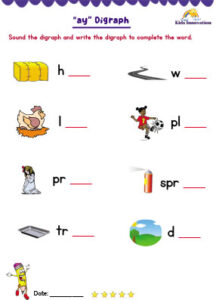
Fill in the Blanks: Another common exercise involves filling in the blanks in words with the correct digraph. For instance, a worksheet might provide the word “___ip” and ask the child to complete it with the “sh” digraph, resulting in “ship.”
Word Building: Children may be asked to use letter cards to build words containing specific digraphs. This hands-on approach helps reinforce the relationship between letters and sounds.
Reading and Writing Sentences: More advanced worksheets may include sentences with digraphs and ask students to read them or write their own sentences using digraph words. This helps them apply their knowledge in context.
Test your kids with 10 multiple choice questions on English Phonics
Digraph Games: Some worksheets incorporate games and interactive elements to make learning more engaging. This can include crossword puzzles, word searches, or matching games.
Practice Sheets: Repetition is essential for learning, so worksheets often provide multiple opportunities for practice. Children can work on these sheets independently or with guidance from a teacher or parent.
Assessment and Progress Tracking: Some worksheets come with assessment sections to evaluate a child’s understanding of digraphs. This allows educators and parents to track the child’s progress and adjust instruction accordingly.
Kindergarten English digraph worksheets are valuable tools for early literacy development. They help children grasp the fundamental concept of digraphs, which is a crucial building block for reading and writing in English. These worksheets provide a structured and systematic way to teach and reinforce digraphs, setting a strong foundation for language skills.
 Skip to content
Skip to content 

3 thoughts on “Kindergarten Phonics Worksheet”